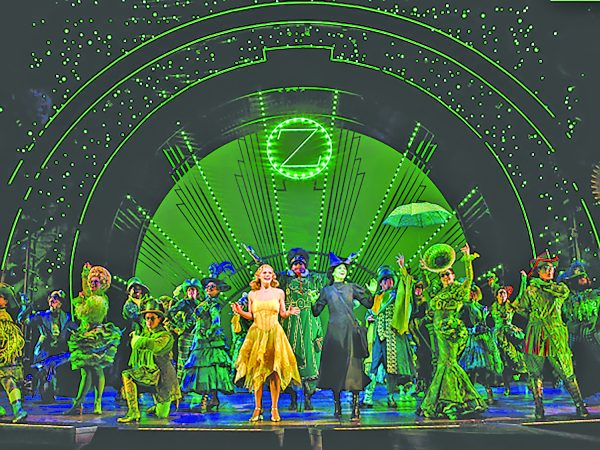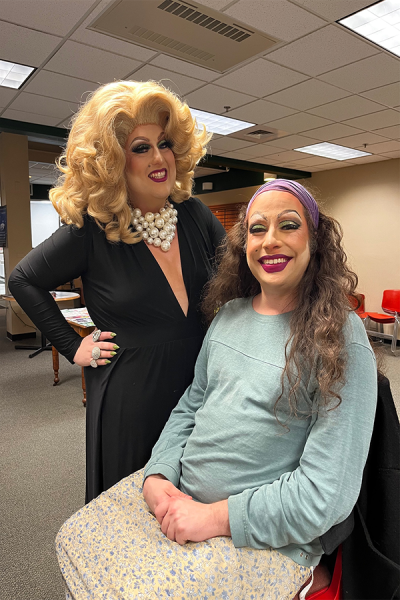Dark wit and shocking twists in “The Beauty Queen of Leenane”
Walking into the Dibden auditorium, it seems as if no one is there. All of the seats are empty and the heavy blue curtains are drawn across the stage. Tentatively, I step onto the stage and am ushered behind the curtain by the two people waiting on the platform.
“The Beauty Queen of Leenane” was designed in black box style — the set was a single, two-sided room with chairs placed along the other two sides. With only 59 available seats per show, it felt cozy and personal, adding to the illusion that this was someone’s living room.
Set in a small town in Ireland, the show was written in 1996 by the Irish playwright Martin McDonough. It is described on Wikipedia as a black comedy, the former aspect of which becomes increasingly apparent as the story progresses. The Johnson production of the show was directed by Will Davis.
The cast was as cozy as the set, with only four character appearing throughout the course of the play.
Molly Burnett played Maureen Folan, a 40-year-old woman who lived with her mother, bitterly taking care of the older woman. The character’s exasperation and desire to be living any other life shone through in every aspect of Burnett’s performance.

Gabrielle Straight as Mag Folan
Maureen’s mother, Mag, was played by Gabrielle Straight, whose near-permanent scowl and frumpy demeanor excellently portrayed the character of a grumpy and particular old woman.
The show’s other two characters were Ray and Pato Dooley, played by Colton White and Sam Lewis. Ray’s main role was that of an aggravated messenger between Pato and Maureen, a role that White executed fantastically with his dramatic gesticulation and forceful line delivery.
Pato played the role of Maureen’s romantic interest. From earnestly romantic scenes with Maureen to a hilariously awkward interaction with Mag the morning after he slept with her daughter, Lewis’s performance helped to make Pato the most sympathetic character in the show.
To give the performances an extra ring of authenticity, all of the actors assumed Irish accents. The results, although not perfect, were surprisingly good, and I give kudos to the cast for taking that extra step out of their comfort zones for the sake of good theater.
The play offered some excellent moments of humor, particularly in the first half, found in both the dialogue and some more physical elements of the performances. Mag’s persistent pessimism, Maureen’s dry wit, Ray’s bumbling and Pato’s awkwardness combined to draw some fantastic laughs from the audience throughout the show.
Apart from the actors’ performances, the most stand-out aspect of the show was the set. Designed by Andrew Tascarella and Kalob Gabree, the small room contained plenty of its own character. From the water-damaged walls to the stone fireplace to the embroidery hung on the chimney, the little room felt thoroughly lived-in and provided an excellent backdrop for the events of the play.
The soundtrack added another touch of detail to the show. In the waiting time before the show began and between each scene, we were treated to a variety of Irish jigs and tracks of a similar musical style. The upbeat nature of the music helped to carry the audience from scene to scene, an aspect of the show that turned slightly eerie when the story took a morbid turn toward the end.
Throughout the show, sound effects added small pops of life to the backdrop (sound design by Tim Melville). The radio acted as a point of contention between Maureen and Mag, and later as an interesting plot point that called back to a song played earlier. Additionally, a faint sound of rain could be heard throughout much of the show, enforcing the idea of a dreary little Irish town that Maureen bemoaned so frequently.

Molly Burnett as Maureen Folan
I’ve seen many plays at Dibden during my years here, and many of them have made me laugh or smile or even become slightly sad, but this is the first one to legitimately shock me. The feeling of closeness to the performance, the compelling portrayals from the cast members and the nuanced foreshadowing throughout the story all served to invest me further into the lives of the characters and surprise me that much more when the story turned dark.
Overall, this was one of the more enjoyable shows I’ve experienced on the Dibden stage (although only the second that I’ve experienced from a seat that was literally on the stage). The depth of the story offered a chance for the actors to show powerful versatility in their performances, and the atmosphere of the set brought the scenery to life as well. “The Beauty Queen of Leenane” is a Dibden production that I won’t be forgetting any time soon.








